“Spring is the time of plans and projects”
-Leo Tolstoy
The spring garden is our excuse for change and renovation. What happens now? We look around and know we can do better! Like you, we add some new plantings every year in the garden.
Spring is also a good time to adjust the garden to meet our current needs. We want to add new ground cover in one spot, this year, and add to the plants we have for pollinators and wildlife. They are lots of fun to watch and we have some ideas for improvement. There is also an opportunity to add color in places that need it and to improve the outdoor seating and cooking space.
What Happens Now? New Plants
In March: Caladiums for Constant Warm Weather Color
We are adding to our collection of Caladiums. These are a plant with large, airy, almost ethereal foliage, In this warm climate, (South Florida, zone 10-find your zone) their tubers are ready to plant now and will flourish throughout the, summer season in any region. Caladiums come in a wide variety of colors. The foliage provides constant color in the warm weather garden. In our near-tropical environment, we plant them in early spring and leave them. In containers, we enjoy them in their season, trim them back when it cools down, plant winter annuals on top and they pop up when the next warm season shows up.
In a temperate climate, you can lift them in the fall and store them for the winter. Also, you can use them in containers, window boxes, and hanging baskets.
A new Caladium for this spring: White Queen

“Jam tomorrow, jam yesterday, but never jam today”
-Through the Looking Glass– Lewis Carroll
In Lewis Carroll’s, ” Through the Looking Glass”, Alice in Wonderland meets the White Queen. Because the queen lives through the looking glass, she lives backward in time. That’s why there is never any “jam today”.

Our new caladiums will arrive soon and they are a regal element! Since they are going in long beds around the house we will not care if they go backward or forward. For our purpose, we need a substantial plant, with a light color and a little drama for our long wet, hot summers.
We have learned to appreciate the value of white and light flowers outdoors on warm evenings. If you would like to explore an evening enhancement to your garden this is a report on a famous “ Moonlight Garden“ which is open to the public. It should give you some ideas.
Adjusting To The Climate
In our climate, summer will be here soon! Everything will be green and our ponds deep and lush, with thick grasses and waterside flowers. However many plants we love do not love our summer humidity. This limits our choices. The caladiums will go into long planting beds that run in and out of sun and shade. We require something that can handle a variety of lighting conditions. If you think you would like caladiums check the varieties offered on the growers’ web pages. They will give you the specific requirements of each variety.

White Queen Caladiums- Features
The White Queen Caladium is a tall plant, for the front of the garden, ranging from 2′-2.5′ in height and has very large and dramatic foliage. The leaf is white with green edging and red venation. Because the red vein color tends to bleed, some leaves will turn pink. They will go in beds with other white and variegated foliage. The light conditions for this variety ranges from shade to sun-making it versatile! You can combine caladiums with seasonal annuals, hostas, ferns, and other foliage plants.
Caladiums originated in the Amazon, and are tropical in nature. You can, however, use them successfully in temperate climates, in the ground, in containers, in hanging baskets and even as house plants. Lift the tubers for winter storage and then use them the next spring, all over again. This article will give you the details you need. “Plant Caladiums in Sun and Shade for Brilliant Color”.
Almost the entire world’s supply of Caladiums is commercially grown in and near the small town of Lake Placid Florida. In July the town holds an annual floral festival and you can visit the fields in an airconditioned bus. They look like fields of Holland tulips! If you would like to see ” Old Florida” while it is still with us, this is a great opportunity.
We bought these from Happiness Farms one of the largest suppliers and an old family business. Just search for Florida Caladiums, you will find a wide range of growers and other sources. They will ship to your zone at the right time to plant.
What Happens Now? Agapanthus
We will add some Agapanthus. These grow from bulbs and provide statuesque globes of flowers on substantial stems. The flowering part of the Agapanthus can be from about 2′ to 6′ high. They fill the eye at the high end of the planting bed. This adds a layer of color and form on top or in front of trees, hedges or fences.
They appear in a variety of shades of blue, white or blue and white. We have grown the pastel blue before and in our South Florida town, our highway department plants them in the medians. This indicates they will grow where we live.
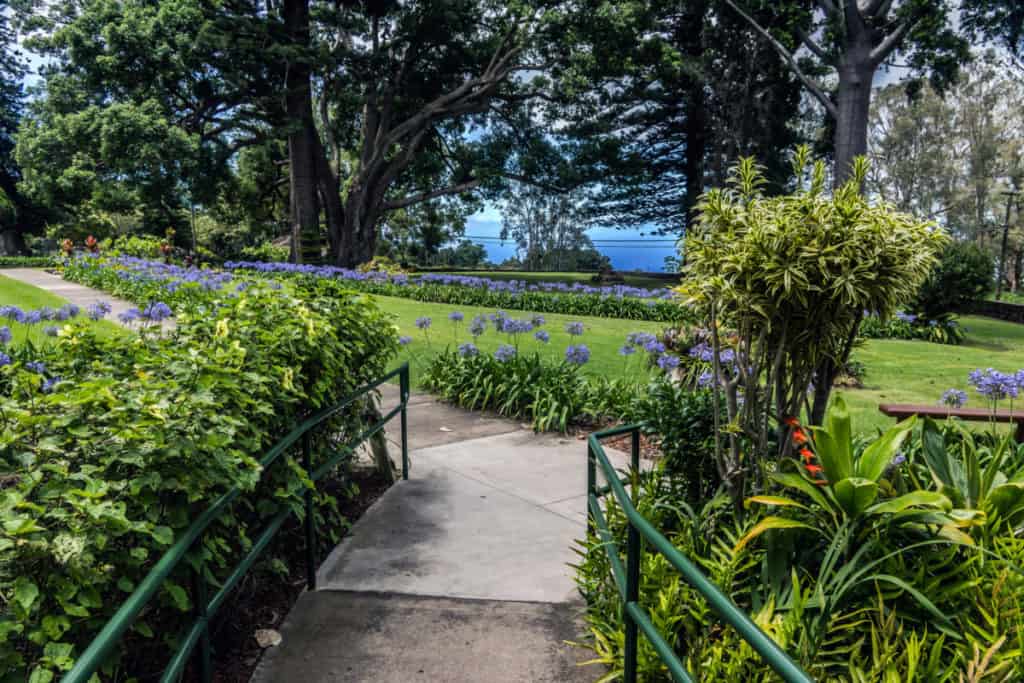
We are going to take a little risk with this one. On a Hawaiian vacation, we saw them in brilliant shades of dark blue. These have terrific drama. They are rated for our hardiness zone (10a) but we do not see many.
They will be an asset in our garden, but we do have our concerns about our long, wet, humid, summers. Here is what we will do to improve our chances of success.
Agapanthus in a Humid Climate
- We will plant them under a medium-sized oak tree. This will reduce the sun a little and provide summer protection.
- Soil drainage; our sandy soil drains quickly, but summer is the worst time for drainage. We will raise the planting bed to ensure the best drainage.
- Start the plants in small pots, they thrive in “snug” positions.
- Stake the tall plants, not usually required for Agapanthus but our hurricane season can be a challenge.
“Agapanthus, for the Victorian Romantic in all of Us.“ will help you plant them.
What Happens Now? Improve With Groundcover
Directly behind the pool, we have an area of fairly high traffic. In our Florida climate, St Augustine Grass is by far the most popular turf. It is a healthy green color with relatively few pests. In most places, for us, it works fine. Its weakness is that is suitable for only moderate traffic. In this area, we have an outdoor cooking station and the traffic keeps growing.
In addition, we have tried hard to create some shade in this part of a hot, sunny backyard. To an area with a few palms and small shrubbery, we added small trees and larger shrubs. The area in question is now more shaded and should become more so. St Augustine grass has varieties for moderate shade, but ours is not one. We think that a low ground cover and perhaps stepping stones are the way to go, as the space is too small for a substantial walkway.
The Ground cover we are considering is one we have used before-Asiatic Jasmine. It is low, shiny green, dense, and very low maintenance. Here is more information on planting groundcovers in your garden.
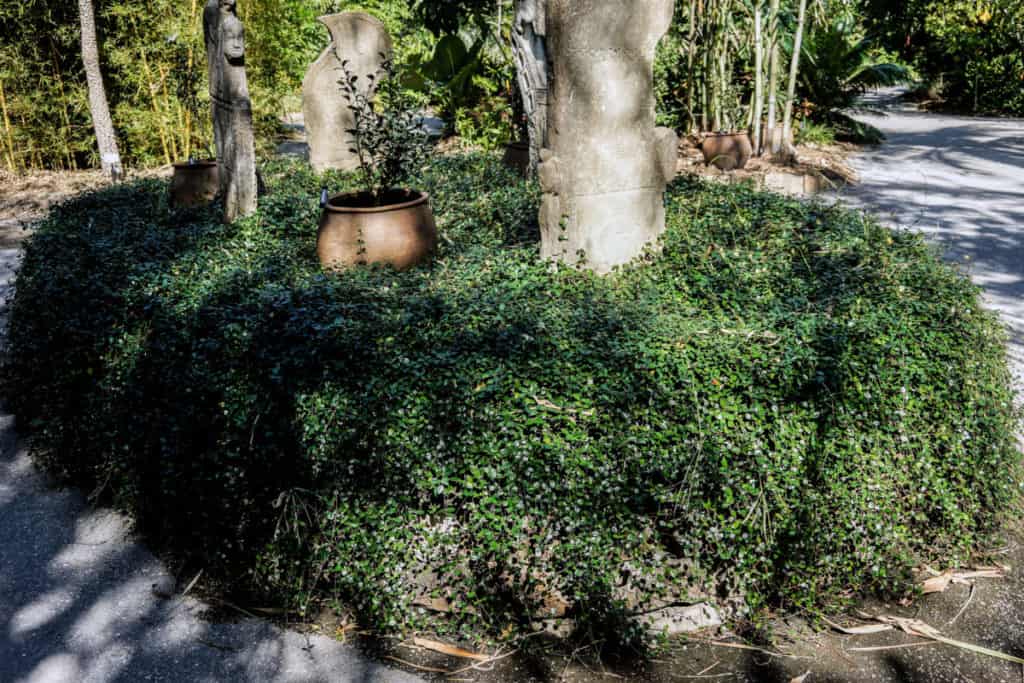
Asiatic Jasmine and Marsh Rabbits
The rabbits are entertaining. Our local rabbit is the Marsh Rabbit, it is a brown rabbit whose ears and fluffy tail are a little smaller than those of the cottontails we all know. What they lack in flash, however, they make up for in inventiveness!
We have chased three of them out of the house!. Curious, they make their way into the garage and from there they can sneak in while we unload groceries. They also can stand on their hind legs and grab at low growing hibiscus blossoms, pulling the tasty flower down with both paws. You can see where this is going! They have a great appreciation for petunias and Blue Daze, a low growing, long-living annual with handsome blue blossoms. (Blue is hard to find in our Florida gardens and this annual lasts 2+ years for us.)
Our salvation is that the rabbits are not tall-we solve the problem with containers.
Asiatic Jasmine
Asiatic Jasmine is a dense, shiny, dark green ground cover. It is a fine foil for floral displays and should make the small space seem bigger. We can add a bench and admire the pond with its birdlife and littoral plantings. In addition to the shiny green color, the jasmine is available in variegated forms. There is a pastel pink, white and green variety and a bright one with red and yellow foliage.
Having planted a little of the variegated cultivar in the front yard, we decided we loved it. Unfortunately, so did the rabbits! The green one is looking better all the time.
What Happens Now? Plantings for Pollinators and Other Wildlife
Shortly after moving into this house, we added some pollinator-friendly plants. There was enough space to add new beds containing Powder Puff plants in pink, a magenta Fire Spike, Dombeya, (also called tropical hydrangea) a yellow trumpet-style Alamanda, and more. The butterflies appreciate Hibiscus in various colors and some tall grasses near the water. As host plants for the butterflies to lay their eggs on we have Milkweed for the Monarchs.
The Monarch Caterpillars will eat the milkweed voraciously. On some occasions, the leaves of a healthy plant can disappear in a few hours. This leaves a useless and unattractive plant in place. This is how we handle it. Keeping the milkweed plants in their original black nursery pots, we disperse them among the other plants. Once eaten down, we discovered we can easily remove them to a place not frequented by the butterflies, The pots are replaced with new plants. (This also allows us to keep reusing the same plastic pots.)
The chewed plants will regrow and we can recycle the whole process. We are getting 3 or more regrowths in the old potted plants. (We hide the battered plants in the herb garden or in a garden inside the screened pool enclosure.
Host Plants for More Butterflies
The way this works is pretty simple. The butterflies come to the garden because we have flowers that provide nectar for them to eat. They will stay in our garden if we provide the kinds of plants which they need to lay their eggs on. The various types of butterflies are very specific about the plants on which they will lay eggs. (For more information see this article )To encourage more types of butterflies to stay we need to add more host plants for them to raise their young.
In our garden, we see Julia butterflies, the flashy Gulf Flitterary and the Zebra Longwing (the black and yellow Fl state butterfly). Fortunately, all three will lay their eggs on the same host plant, the Passion Vine (Passiflora).
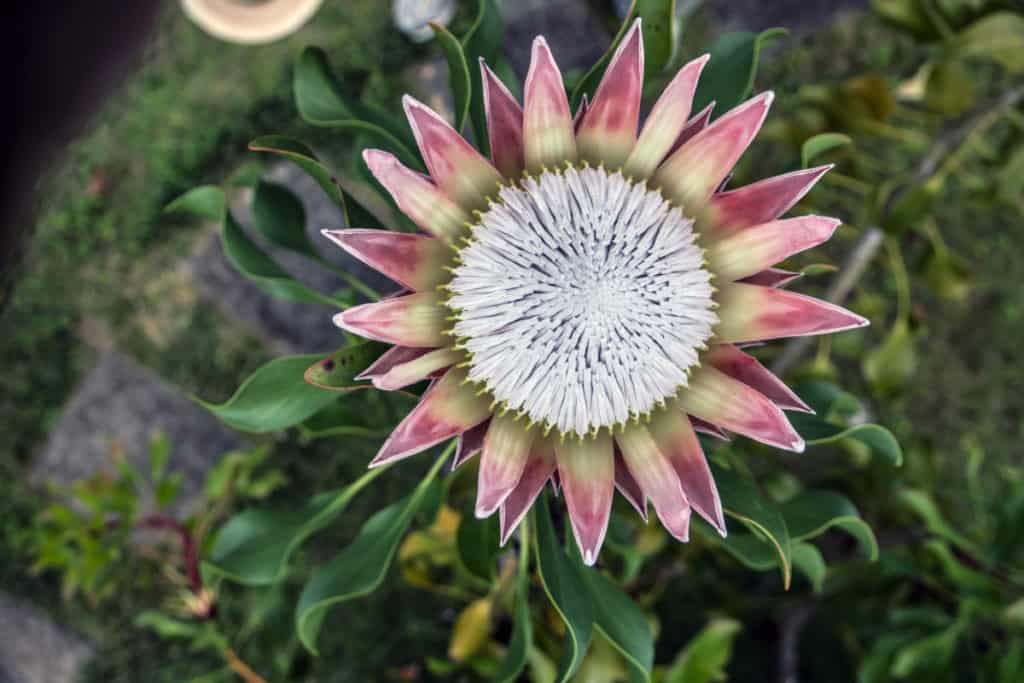
Passion Vine
This is a vine that many butterflies love. There are 400-500 species and they come in brilliant colors. The flowers range from 1/2″-6″ in diameter. They climb with tendrils. The tendrils grab tightly to the arbor, trellis or fence you place them near. One of our popular local writers claims that he bought a bunch from a grower who was a 2-hour drive away. He says that when he got home they had attached themselves to the seat belts! (Another reason not to leave any new plants in the car overnight!)
The very beautiful flower in the picture above is Passiflora sprucei. We love it and it is very successful in our climate. It is however very large and requires more space than we can allocate to it. We have planted the little cousin, Passiflora suberosa, also called the corky stemmed passion vine. It can become long but takes up a lot less space. It is fast-growing and seems to be pest-free. The small flower is white with light green and light yellow accents. In our garden we have planted one in a little shade, the other should receive more sun. This is because one butterfly, the zebra longwing prefers more shade.
We will pinch the young tendrils to encourage more vining ( and therefore more food for the caterpillars).
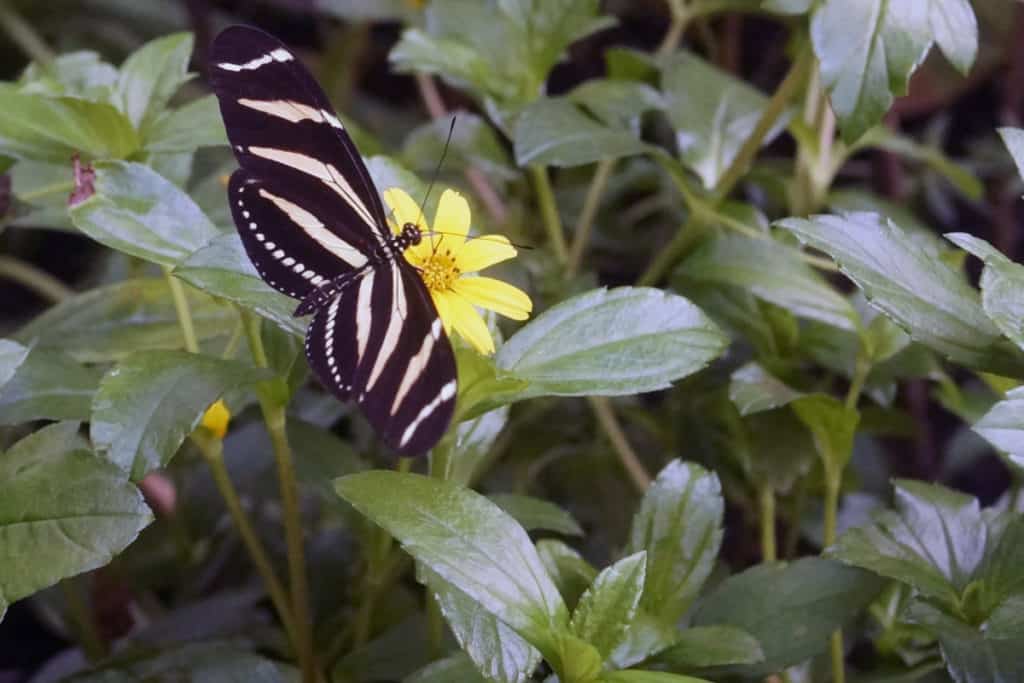
Wildlife at the Pond Edge
The ponds are pleasant but the borders are bare and boring. This bare edge also risks erosion. We have added a collection of pond edge plantings along the littoral shelf. (This is the shallow shelf at the edge of a water body. Planted with aquatic plants it filters nutrients and minerals in the water.) In our climate, for the freshwater ponds, these work well. Duck Potato plant with white flowers above green foliage, yellow Canna Flaccida, and blue native iris. They have a lovely blue flower with a yellow accent. They are a little like the Siberian iris we enjoyed in the north with taller stems. Along the lawn edge, we have Muhlenbergia grass which, attractive anytime, in fall turns a brilliant magenta color.
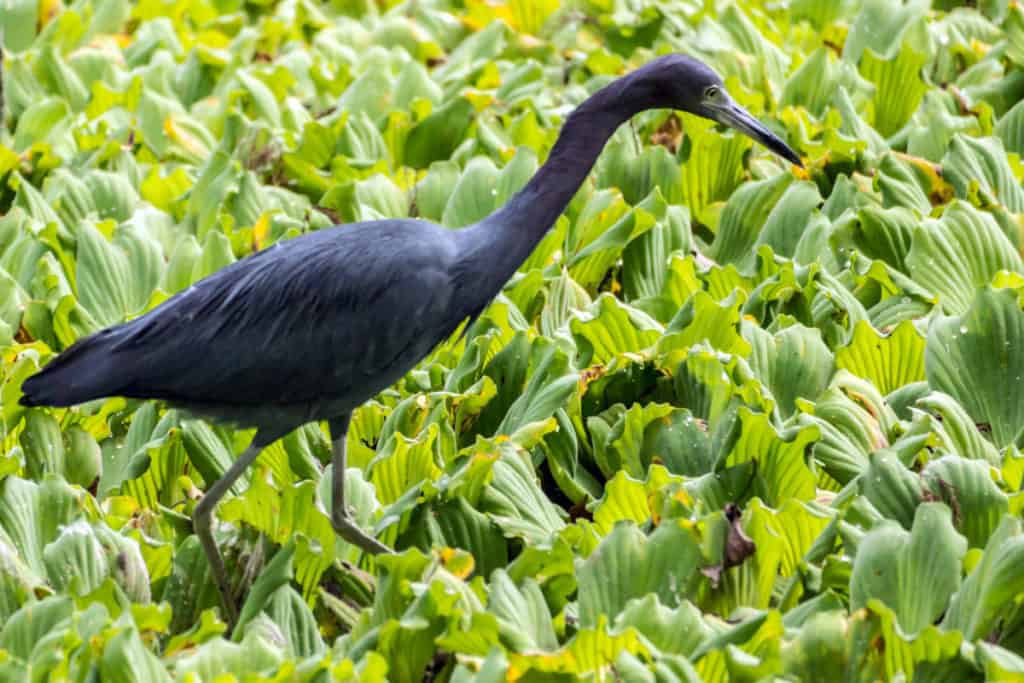
We are hoping to attract wading birds with these plants and think that it seems to be working. The builder of our community installed a long foundation hedge near the house. It is a green Florida native plant called a Simpson’s Stopper -Myrcianthes fragrans. It has a small white blossom followed by a red and yellow berry. The flower as you guessed has a pleasant fragrance little bit sweet, a little bit spicy. This berry keeps the birds happy. The critical step here for wildlife was to keep the hedge tall enough to produce the blossom and berry.
I think the lesson learned here, is to know how to use the plant material we have. This is an attractive hedge, the scented blossom is a nice little bonus. The important thing for the wildlife was to learn how to trim it. leave the plant a few inches taller than it’s initial trimming made it a bird attractant.
The Bonus-Hummingbirds!
We live in a neighborhood where hummingbirds were not found! Enhancing the plantings for birds and pollinators brought the hummingbirds too!
Summary
This is the plan for our spring season. I’ll tell you how it works out!
